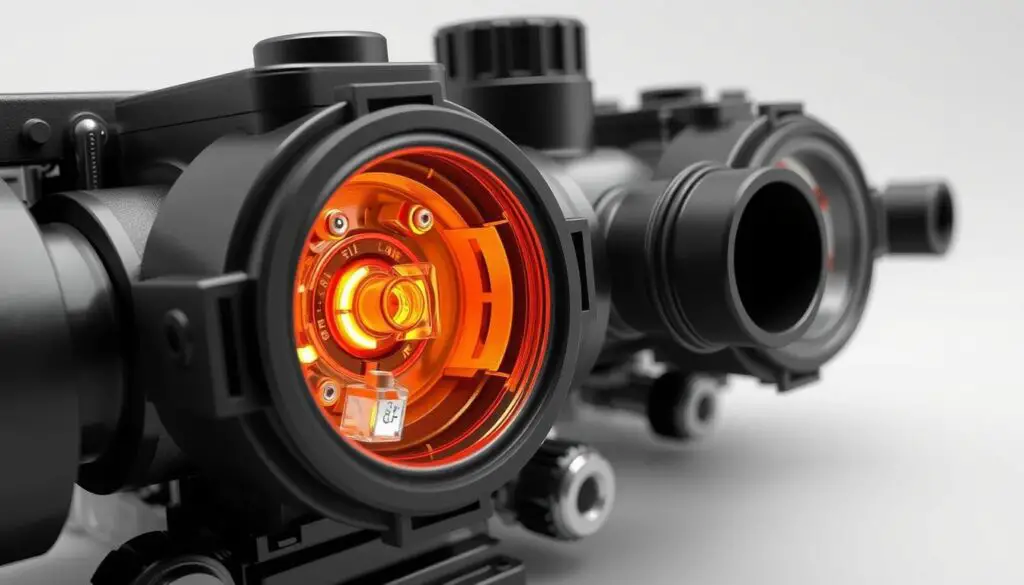Diagnosing issues with the Kubota fuel shut-off solenoid is crucial for maintaining the health and efficiency of your equipment. A malfunctioning solenoid can lead to a range of problems, from decreased performance to complete engine failure.
The solenoid plays a vital role in controlling the fuel flow to the engine. When it fails, it can cause significant disruptions. Understanding how to identify and fix solenoid troubles is essential for any equipment owner or operator.
Key Takeaways
- Understanding the role of the Kubota fuel shut-off solenoid in engine performance.
- Identifying common signs of solenoid malfunction.
- Steps to diagnose issues with the solenoid.
- Methods for repairing or replacing a faulty solenoid.
- Tips for maintaining the solenoid to prevent future issues.
Understanding the Kubota Fuel Shut-Off Solenoid
Understanding the Kubota fuel shut-off solenoid is essential for diagnosing and repairing issues. The fuel shut-off solenoid is a critical component that controls fuel flow to the engine.
What Is a Fuel Shut-Off Solenoid?
A fuel shut-off solenoid is an electromagnetic device that regulates fuel supply to the engine. It acts as a valve, opening and closing to allow or stop fuel flow.
How It Functions in Kubota Engines
In Kubota engines, the fuel shut-off solenoid functions by receiving an electrical signal from the ignition switch. When the signal is present, the solenoid opens, allowing fuel to flow.
Common Kubota Models and Their Solenoid Specifications
Different Kubota models have specific solenoid requirements. Here’s a brief overview:
| Kubota Model | Solenoid Specification |
|---|---|
| B2620 | 12V, 2-wire |
| L6060 | 12V, 3-wire |
| M5-111 | 24V, 2-wire |
It’s crucial to consult the owner’s manual or manufacturer’s specifications for the correct solenoid type for your Kubota model.
Kubota Fuel Shut-Off Solenoid Troubles: What to Look For and How to Fix
The Kubota fuel shut-off solenoid plays a critical role in engine operation, and its failure can manifest in several ways. Understanding the common symptoms of solenoid failure is essential for diagnosing and fixing the problem efficiently.
Common Symptoms of Solenoid Failure
A failing Kubota fuel shut-off solenoid can exhibit a range of symptoms. Some of the most common issues include:
- Engine failure to start or sudden shutdowns
- Irregular idling and performance issues
- Clicking sounds or other unusual noises
Engine Won’t Start or Suddenly Shuts Down
If your Kubota engine fails to start or shuts down unexpectedly, it could be a sign of solenoid failure. This is often due to the solenoid not functioning correctly, preventing the engine from receiving the necessary fuel.
Irregular Idling and Performance Issues
Irregular idling, such as rough idling or stalling, can also indicate a problem with the fuel shut-off solenoid. Additionally, performance issues like decreased power or efficiency can be related to solenoid malfunction.

Clicking Sounds and Other Warning Signs
Clicking sounds or other unusual noises coming from the solenoid area can be a clear indication of an issue. It’s essential to investigate these sounds promptly to prevent further damage.
By recognizing these symptoms, you can take the first steps towards diagnosing and fixing the problem with your Kubota fuel shut-off solenoid.
Essential Tools and Safety Precautions
To ensure a safe and effective repair process, it’s essential to understand the necessary tools for solenoid repair and precautions for working with your Kubota fuel shut-off solenoid.
Required Hand Tools and Electrical Testing Equipment
For diagnosing and repairing the Kubota fuel shut-off solenoid, you’ll need a set of basic hand tools, including pliers, screwdrivers, and wrenches. Additionally, electrical testing equipment like a multimeter is crucial for assessing the solenoid’s electrical circuit.
Safety Measures When Working with Fuel Systems
Working with fuel systems requires strict safety precautions to prevent accidents. Ensure your workspace is well-ventilated, and avoid any open flames or sparks. Wear protective gear, including gloves and safety glasses.
Workspace Preparation Guidelines
Before starting the repair, prepare your workspace by clearing any clutter and ensuring good lighting. This will help you work efficiently and safely. Also, have a fire extinguisher rated for fuel fires nearby.
Step-by-Step Diagnostic Procedure
To identify problems with the Kubota fuel shut-off solenoid, follow a step-by-step diagnostic procedure. This systematic approach will help you pinpoint the root cause of the issue, ensuring that you can take the necessary corrective actions.
Visual Inspection Techniques
A thorough visual inspection is the first step in diagnosing solenoid issues. Look for signs of wear, damage, or corrosion on the solenoid and its connections. Check the wiring for any signs of fraying or damage.
Testing Electrical Connections and Wiring
Next, test the electrical connections and wiring to ensure they are secure and functioning properly. Use a multimeter to check for voltage at the solenoid when the ignition is turned on.
Measuring Solenoid Resistance and Continuity
Measuring the solenoid’s resistance and checking for continuity are crucial steps. Use a multimeter to measure the resistance across the solenoid’s terminals. Compare your reading to the specifications provided in your Kubota repair manual.
Checking for Mechanical Obstructions
Finally, check for any mechanical obstructions that could be preventing the solenoid from functioning correctly. Ensure that the solenoid is properly seated and that there are no blockages in the fuel system.
By following these steps, you can effectively diagnose issues with your Kubota fuel shut-off solenoid and take the necessary steps to repair or replace it.
How to Test a Kubota Fuel Shut-Off Solenoid
Testing a Kubota fuel shut-off solenoid is a crucial diagnostic step for identifying issues with your engine’s fuel system. This process involves using a multimeter to check the solenoid’s electrical properties, both on and off the engine.
Bench Testing Methods with Multimeter
To test the solenoid on a bench, you’ll need a multimeter set to the ohms function. Disconnect the solenoid from the engine and any electrical connectors. Measure the resistance across the solenoid’s terminals. A functioning solenoid typically has a resistance between 5 to 15 ohms, but always refer to your Kubota manual for specific values.
In-Situ Testing While Mounted on Engine
When testing the solenoid while it’s still mounted on the engine, ensure the engine is turned off. Use your multimeter to check the voltage supply to the solenoid. With the ignition turned on, you should read the battery voltage at the solenoid’s electrical connector. If not, there’s an issue with the wiring or ignition circuit.
Interpreting Test Results
Understanding the test results is crucial for diagnosing solenoid issues accurately.
Normal Operating Parameters
A solenoid is considered functioning correctly if it shows the specified resistance (usually between 5-15 ohms) and operates when the correct voltage is applied. The solenoid should click when energized, indicating it’s working.
Failure Indicators and What They Mean
If your multimeter readings show zero or very low resistance, the solenoid might be short-circuited. Conversely, very high resistance or an open circuit reading indicates the solenoid is faulty and needs replacement. Failure to click when energized also suggests a malfunction.
| Test | Normal Reading | Indication of Failure |
|---|---|---|
| Resistance Check | 5-15 ohms | Short circuit or open circuit |
| Voltage Supply Check | Battery Voltage | No voltage or low voltage |
| Operational Check | Solenoid Clicks | No click when energized |
Replacing a Faulty Solenoid: Complete Guide
To get your Kubota engine running smoothly again, replacing the faulty fuel shut-off solenoid is essential. This process involves several critical steps that must be followed carefully to ensure a successful replacement.
Removing the Old Solenoid Safely
Before starting the replacement process, it’s crucial to disconnect the battery to prevent any accidental engine starts. Always refer to your Kubota engine’s manual for specific instructions on safely disconnecting the battery and accessing the solenoid. Once accessed, carefully disconnect the electrical connectors and any fuel lines attached to the solenoid. It’s a good practice to label these connections to make reinstallation easier.
Selecting the Correct OEM or Aftermarket Replacement
When it comes to replacing the Kubota fuel shut-off solenoid, you have the option of choosing between an Original Equipment Manufacturer (OEM) part or an aftermarket replacement. OEM parts are designed to meet the manufacturer’s specifications, ensuring a precise fit and function. Aftermarket parts, on the other hand, can offer cost savings but may vary in quality. “The choice between OEM and aftermarket parts depends on your priorities regarding cost, quality, and warranty,” as noted by industry experts.
Step-by-Step Installation Instructions
Installing the new solenoid involves reversing the steps taken to remove the old one. Ensure all electrical connectors and fuel lines are securely attached. Double-check that all connections are tight and not leaking to prevent future issues. Refer to your engine’s manual for any specific torque specifications for the solenoid’s mounting.
Post-Installation Testing and Verification
After installing the new solenoid, it’s essential to test it to verify that it’s working correctly. Turn the key to the “on” position and listen for the solenoid’s click, indicating it’s engaging. Also, check for any signs of fuel leaks around the solenoid and connections. A successful replacement will have your Kubota engine running smoothly and efficiently.
Troubleshooting Related Issues Often Confused with Solenoid Problems
Distinguishing between Kubota fuel shut-off solenoid problems and other engine issues can be challenging, but it’s essential for effective troubleshooting. Other components and systems can exhibit similar symptoms, making it crucial to consider these potential causes before diagnosing a solenoid failure.
Fuel System Blockages and Contamination
Fuel system blockages and contamination can significantly impact engine performance, often mimicking solenoid failure. Inspecting the fuel filter and lines for blockages or damage is a critical step. Contamination can lead to clogged fuel injectors or filters, causing engine stalling or failure to start.
Battery and Electrical System Failures
A weak or dead battery, or electrical system failures, can also cause symptoms similar to solenoid issues. Checking the battery voltage and condition is a straightforward step in diagnosing these problems. Electrical system failures can lead to irregular engine behavior, including stalling or failure to start.
Glow Plug and Ignition Issues
Glow plug or ignition system problems can be mistaken for solenoid issues, especially in diesel engines. Testing glow plugs and ensuring the ignition system is functioning correctly can help identify these issues.
| Issue | Symptoms | Diagnostic Steps |
|---|---|---|
| Fuel System Blockages | Engine stalling, failure to start | Inspect fuel filter and lines |
| Battery and Electrical Failures | Irregular engine behavior, stalling | Check battery voltage and condition |
| Glow Plug and Ignition Issues | Difficulty starting, engine misfires | Test glow plugs, check ignition system |
When to Consult a Professional Technician
If you’re unsure about the cause of your Kubota’s issues or if troubleshooting steps don’t resolve the problem, it’s time to consult a professional technician. They can provide a more detailed diagnosis and repair, ensuring your engine operates efficiently and effectively.
Conclusion
Diagnosing and fixing Kubota fuel shut-off solenoid issues requires a thorough understanding of the component’s function and common failure symptoms. By following the steps outlined in this article, you can effectively identify and repair solenoid problems, ensuring your Kubota engine operates efficiently.
A key aspect of diagnosing solenoid issues is to perform a systematic check of the electrical connections, wiring, and solenoid resistance. This process helps determine if the solenoid is faulty or if other factors are contributing to the problem. For a Kubota solenoid repair summary, it’s essential to verify the solenoid’s operation and check for any mechanical obstructions.
By understanding the causes of solenoid failure and how to diagnose these issues, you can take proactive steps to prevent future problems. Whether you’re a seasoned mechanic or a DIY enthusiast, being able to diagnose and fix solenoid issues will help you maintain your Kubota equipment’s performance and extend its lifespan.
For further guidance on maintaining your Kubota engine or troubleshooting other common issues, consult the owner’s manual or seek advice from a certified Kubota technician. Effective diagnosing solenoid issues is crucial for optimal engine performance.





